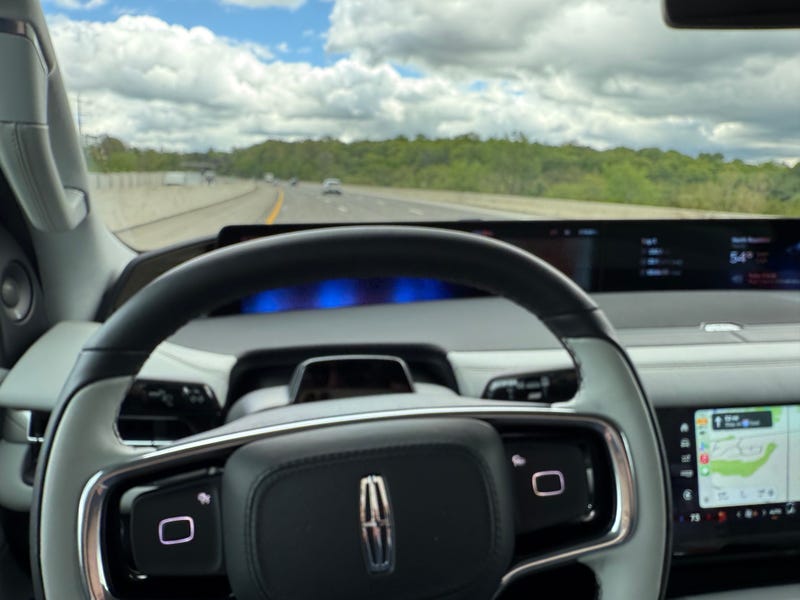
(WWJ) The mission: Drive as many hands-free miles as possible.
The objective: A Memorial Day Weekend road trip to Pittsburgh to celebrate the anniversary of my brother and sister-in-law.
The vehicle: A 2025 Lincoln Navigator with BlueCruise 1.4, provided by the company to allow me to check out Ford’s latest hands free driving technology on a reasonably long road trip.
I’ve spent a lot of time with hands free technology on a variety of vehicles, but road trips are the best way to really check things out: Mile after mile after mile of boring interstate driving, punctuated by occasional construction, speed traps, accidents and bad weather.
The evening before the trip, I took the Navigator to Comerica Park. During a quick trip down the Jeffries Freeway, it never once asked me to take control. It was even able to navigate several construction zones. In some cases–in an abundance of caution–I took control myself.
In my mind, this is rule number one of hands free driving: Don’t give the system the chance to make a mistake. If you’re not comfortable, drive the car yourself.
You’ll become more comfortable. Traffic jams are an issue with me, but they are also an opportunity to relieve some stress while driving. We did run into some fast changing traffic during rush hour, and the system worked great. Deceleration and acceleration weren’t as smooth as if I was handling the controls, but I can sense the improvement from earlier systems.
My first issue came the next morning. I got a warning light to clear the front camera. That prompted a lot of questions. Where is the front camera? Will this impact the Blue Cruise system? Is it really dirty or is it just the morning dew that will burn off.
For the record, thanks to the online manual, I found that the camera is in the front grill. But by then the sun was up and the warning light was gone. So I think I’m ok…but I better pack a roll of paper towels, just in case.
Time to hit the road.
Two things are obvious right away. The updated version of BlueCruise does not hand control back to the driver as much as previous versions did. The other thing is that there are still a number of times when, as the driver, I took control. I believe the right words are “Out of an abundance of caution.”
There are those times when you just aren’t sure what other drivers are going to do. Hands go back on the wheel. There are also those times, particularly on I-75, when you are surrounded by 18-wheelers.
Construction zones are a mixed bag. The Ohio Turnpike is full of them. In most cases BlueCruise remained engaged. It did a surprisingly good job of differentiating between the current lines on the road, and older lines that are covered up but are still visible.
Lane shifts are a different thing. Mostly it gave control back. Sometimes I took control. Narrow lanes were certainly a time when you need to be hands on.
Then there are the sunglasses. BlueCruise does not like my sunglasses. Maybe it’s because they are polarized. Maybe it’s because they’re bifocal. It can’t be because they’re cheap.
I kept getting “eyes on the road” messages, when my eyes were firmly planted on the road.
Quick solution: My wife’s sunglasses.
Not quite a fashion statement, but I got no unnecessary warnings.
On that same subject, BlueCruise also gave me “eyes on the road” warnings when I yawned. I’m not sure what the physiological reason for that may be. And, don’t spend too much time trying to adjust the radio or climate, or you’ll get a warning as well.
I’m also a little confused on just when BlueCruise is actually ready. On most trips, I got a quick message that it was ready to go. On my trip home Sunday morning, a beautiful sunny day, it probably took me about 5 minutes of driving on the Pennsylvania Turnpike before the system was comfortable enough to let me take my hands off the wheel.
While we’re on the subject of the Pennsylvania Turnpike, it’s a different animal than most limited access roads. It’s windy, hilly, and the lanes are often narrow. There are areas where you have concrete barriers very close to the side of the road.
BlueCruise was more comfortable with those barriers than I was. There were time that I felt I just had to take control.
And the hilly windy roads, tend to make you feel like you’re less in control. I call it the “runaway train” effect. It’s psychological, but BlueCruise obviously has to adjust more, and you feel it. I don’t think I every got totally used to it.
I had two times when I went from two lanes to three while on BlueCruise. Once the system just took me right into the center lane. The other time an alarm went off and I was told to take control. That’s one of the few times that happened in more than ten hours of driving. That’s a big improvement over previous editions of BlueCruise.
BlueCruise will do lane changes for you. Just tap on the turn signal and it will look for an opening and move right in. It generally worked well, but i did feel in one case it was a bit aggressive and cut off a driver who was speeding up.
No word when they may add automatic lane changes like GM has on Super Cruise.
To wrap it up, GM’s Super Cruise remains the gold standard for hands free driving systems, but Ford’s BlueCruise is fast closing the gap. I found the system very easy to use, very easy to coordinate with and much more efficient than it’s been in the past. I can’t wait to see what they do next.
